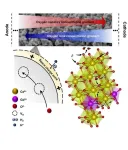(Press-News.org) The University of Houston College of Pharmacy is included in a $68.5 million funding package from the Cancer Prevention and Research Institute of Texas (CPRIT).
Ming Hu, Diana S-L. Chow Endowed Professor of Drug Discovery and Development, and Gregory Cuny, Joseph P. & Shirley Shipman Buckley Endowed Professor of Drug Discovery, received $1.4 million to fight familial adenomatous polyposis (FAP), a devastating and rare genetic disorder of the gastrointestinal tract that can cause hundreds or thousands of polyps inside the colon or rectum.
No effective treatment exists for FAP, which impacts 1-in-10,000 people, and unless the colon is surgically removed at an early age, 100% of patients will develop cancer.
There was once a glimmer of hope in the form of celecoxib, a selective COX-2 (cyclooxygenase 2) inhibitor, that was previously approved to treat FAP. COX-2 is an enzyme involved in the inflammation process. Unfortunately, its use for FAP was withdrawn because chronic use of celecoxib, which inhibits polyp growth, causes rare but serious cardiovascular toxicities including death.
Hu and Cuny are set to design new drugs to battle FAP, ones that will inhibit the activity of COX-2 in specific local areas of the body without affecting the entire body.
"We propose to develop locally bioavailable (i.e., no systemic exposure and toxicities) selective COX-2 inhibitors that are only available in the colon to suppress colonic COX-2 expression and reduce prostaglandin E2 levels, which is known to promote tumor growth,” said Hu.
The locally bioavailable drugs will know exactly where to go in the body, designed to use the body’s normal physiological processes to go straight to the areas of need.
“They target the areas by being slowly metabolized in the colon but rapidly metabolized in the liver via a process called glucuronidation and undergoing recycling backed to the colon, minimizing systemic exposure,” said Cuny. “Our lead compound LBD-01 already has these properties, but its anti-COX-2 activity is lower than celecoxib. Hence, our research goal is to obtain more active compounds, while maintaining local bioavailability in the colon.”
The project is co-led by three contributing investigators with complementary expertise: Noah Freeman Shroyer, Baylor College of Medicine; Dr. Eduardo Vilar Sanchez, a clinician who treats FAP patients at M.D. Anderson Cancer Center; and Rashim Singh, UH College of Pharmacy.
“Our project holds great promise for FAP patients by providing a new treatment paradigm that would be safe and effective,” said Hu.
According to CPRIT, Texas leads the nation in its commitment to the war on cancer. Since 2010, CPRIT has funded 1,967 awards for cancer research, product development and prevention for a total amount of $3,542,257,795. For a complete list, click here.
END
CPRIT grant supports UH College of Pharmacy fight against rare genetic disorder
Gastrointestinal condition has no known treatment
2024-03-11
ELSE PRESS RELEASES FROM THIS DATE:
Trauma screening may improve mental health service recommendations for children
2024-03-11
UNIVERSITY PARK, Pa. — Each year between 200,000 and 270,000 children and youth enter foster care placements with child welfare services, and many more children receive child welfare services while remaining in their parent's care, according to the U.S. Department of Health and Human Services. Although many of these children have a documented history of abuse or neglect, children may respond differently to incidents of maltreatment or other potentially traumatic events. Incorporating a trauma screening — which assesses how trauma and maltreatment affected each child — into the child welfare evaluation process provides information that could be used to ...
Wrist device that monitors activity could help provide early warning of Alzheimer’s
2024-03-11
Monitoring daily activity patterns using a wrist-worn device may detect early warning signs of Alzheimer’s disease, according to a new study led by researchers at the Johns Hopkins Bloomberg School of Public Health.
The researchers analyzed movement data from wristwatch-like devices called actigraphs worn by 82 cognitively healthy older adults who were participants in a long-running study of aging. Some of the participants had detectable brain amyloid buildup as measured by PET scan. Buildup of the protein amyloid beta in the brain is a key feature of Alzheimer’s disease.
Using a sensitive statistical technique, the ...
Synergistic proton and oxygen-ion transport in fluorite oxide-ion conductor
2024-03-11
They published their work on new superionic mechanism in fluorite oxide electrolyte for low temperature protonic ceramic fuel cells in Energy Material Advances.
"The development of low-temperature and high-performance solid oxide fuel cells is imperative." said corresponding author Dr. Jianbing Huang, Associate Professor of the State Key Laboratory of Multiphase Flow in Power Engineering, Xi'an Jiaotong University.
Dr. Huang explained that protonic ceramic fuel cell has several significant advantages as an alternative solid oxide fuel cell ...
Complex chemistry in the cold depths of space (video)
2024-03-11
WASHINGTON, March 11, 2024 — For years, scientists thought some complex molecules could only be formed on Earth. But what if we found these kinds of molecules out in space after all? In this episode of Reactions, we explore new findings that show complex carbon ring structures can be formed in space, and what that might mean for biology, chemistry and our own chemical history! https://youtu.be/Jh_O5JP10aQ?si=HFvdSchFY95y4idV
Reactions is a video series produced by the American Chemical Society and PBS Digital Studios. Subscribe to Reactions at http://bit.ly/ACSReactions and follow us on Twitter @ACSReactions.
The ...
TaskMatrix.AI: Making big models do small jobs with APIs
2024-03-11
A research team at Microsoft has designed an efficiency tool called TaskMatrix.AI that can be used to accomplish a wide variety of specific AI tasks. TaskMatrix.AI connects general-purpose foundation models like GPT-4, the model behind ChatGPT, with specialized models suitable for certain tasks — much like a human project manager. This research was published Feb. 16 in Intelligent Computing, a Science Partner Journal.
Foundation models and specialized models usually have different mechanisms thus are not easily compatible. Rather than modifying and integrating existing models, TaskMatrix.AI bridges the gaps between them through application ...
Turns out—male roundworms are picky when choosing a mate, new research finds
2024-03-11
A piece of rotting fruit is likely covered in hundreds if not thousands of microscopic roundworms, including C. elegans—a popular experimental model system for studying neurogenetics. With a lifespan of only a few weeks, C. elegans must reproduce quickly and often. The species is made up of hermaphrodites and males. The hermaphrodites have female bodies, can self-fertilize, and can mate with males. Recent research from of the Portman Lab at the Del Monte Institute for Neuroscience at the University of Rochester, found the males do not mate indiscriminately—they are selective about things like age, mating history, and nutrition.
“We ...
Anemonefish are better taxonomists than humans
2024-03-11
Anemonefish form mutualistic relationships with the sea anemones they live in and these associations are not random: some species such as the yellow-tail anemonefish (Amphiprion clarkii) are generalists and can live in almost any sea anemone, others like the tomato clownfish (Amphiprion frenatus) are specialists, living in only one sea anemone species, the bubble-tip sea anemone (Entacmaea quadricolor). Reasons for these preferences are unclear because we know very little about the genetic diversity of giant sea anemones.
Researchers at the Marine Eco-Evo-Devo Unit and Marine Genomics Unit at the Okinawa Institute of Science ...
Social determinants of health and redirection of care for infants born extremely preterm
2024-03-11
About The Study: In this study of 15,000 infants born extremely preterm, redirection of care discussions (withdrawal, withholding, or limiting escalation of treatment) occurred less often for Black and Hispanic infants than for white and non-Hispanic infants. It is important to explore the possible reasons underlying these differences.
Authors: Jane E. Brumbaugh, M.D., of the Mayo Clinic in Rochester, Minnesota, is the corresponding author.
To access the embargoed study: Visit our For The Media website at this link https://media.jamanetwork.com/
(doi:10.1001/jamapediatrics.2024.0125)
Editor’s ...
Generative AI to transform inpatient discharge summaries to patient-friendly language and format
2024-03-11
About The Study: The findings of this study of 50 discharge summaries suggest that large language models can be used to translate discharge summaries into patient-friendly language and formats that are significantly more readable and understandable than discharge summaries as they appear in electronic health records. However, implementation will require improvements in accuracy, completeness, and safety. Given the safety concerns, initial implementation will require physician review.
Authors: Jonah ...
Permitless open carry laws may lead to more firearm-related suicides
2024-03-11
Key Takeaways
Suicide by firearm rates increased 18% in nine years in states that began allowing firearm owners to openly carry a firearm without a permit, a new study finds.
U.S. rates of firearm-related suicide rose from 21,175 in 2013 to 26,328 in 2021, an increase that may be related to more permissive open carry laws.
CHICAGO: In states that relaxed firearm laws to allow openly carrying a loaded firearm in public without a permit, significantly more people died by firearms and ...
LAST 30 PRESS RELEASES:
This new understanding of T cell receptors may improve cancer immunotherapies
A new fossil face sheds light on early migrations of ancient human ancestor
A new immunotherapy approach could work for many types of cancer
A new way to diagnose deadly lung infections and save lives
40 percent of MRI signals do not correspond to actual brain activity
How brain-inspired algorithms could drive down AI energy costs
Gum disease may be linked to plaque buildup in arteries, higher risk of major CVD events
Contrails are a major driver of aviation’s climate impact
Structure of dopamine-releasing neurons relates to the type of circuits they form for smell-processing
Reducing social isolation protects the brain in later life
Keeping the heart healthy increases longevity even after cancer
Young adults commonly mix cannabis with nicotine and tobacco
Comprehensive review illuminates tau protein's dual nature in brain health, disease, and emerging psychiatric connections
Book prepares K-12 leaders for the next public health crisis
Storms in the Southern Ocean mitigates global warming
Seals on the move: Research reveals key data for offshore development and international ecology
Sports injuries sustained during your period might be more severe
World's first successful 2 Tbit/s free-space optical communication using small optical terminals mountable on satellites and HAPS
Can intimate relationships affect your heart? New study says ‘yes’
Scalable and healable gradient textiles for multi‑scenario radiative cooling via bicomponent blow spinning
Research shows informed traders never let a good climate crisis go to waste
Intelligent XGBoost framework enhances asphalt pavement skid resistance assessment
Dual-function biomaterials for postoperative osteosarcoma: Tumor suppression and bone regeneration
New framework reveals where transport emissions concentrate in Singapore
NTP-enhanced lattice oxygen activation in Ce-Co catalysts for low-temperature soot combustion
Synergistic interface engineering in Cu-Zn-Ce catalysts for efficient CO2 hydrogenation to methanol
COVID-19 leaves a lasting mark on the human brain
Scientists use ultrasound to soften and treat cancer tumors without damaging healthy tissue
Community swimming program for Black youth boosts skills, sense of belonging, study finds
Specific depressive symptoms in midlife linked to increased dementia risk
[Press-News.org] CPRIT grant supports UH College of Pharmacy fight against rare genetic disorderGastrointestinal condition has no known treatment







